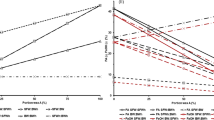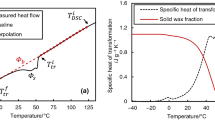Abstract
The thermal behaviour of Jojoba (Simmondsia chinensis) liquid wax was studied by differential scanning calorimetry (DSC), varying the annealing conditions. The fusion enthalpy (ΔHf) of the unannealed material was 27.1 cal/g; the relationship between heat capacity (Cp) and temperature could be expressed by the following equation:Cp=9.51×10−4 T+0.129. It was found that Jojoba wax presents four endothermic transitions (α, β, γ andδ) including fusionα, estimable at low heating rates (1 K/min); the activation energies (Ea) for transitionsα andγ were 51.18 and 64.82 Kcal/mole respectively; and it was observed that the transition temperaturesα andγ maintained a lineal relationship with the square root of the heating rate (Hr).
Résumé
Le comportement thermique de la cire liquide de Jojoba (Simmondsia chinensis) a été étudié par analyse calorimétrique différentielle (DSC) en faisant varier les conditions de recuit. L'enthapie de fusion (ΔH f) de l'échantillon non recuit est de 27,12 cal/g; le rapport entre la chaleur spécifique (C p) et la température a pu être exprimé par l'équation suivante:C p=9.51×10−4T+0.129. On a trouvé que la cire de Jojoba présente quatre transitions endothermiques (α, β, γ etδ) en incluant la fusionα, décelable aux faibles vitesses de chauffage (1°/min); les énergies d'activation respectives (E ac) se sont élevées à 51.18 et 64.82 kcal/mol pour les transtions a etγ sont en relation linéaire avec la racine carrée de la vitesse de chauffage (H r).
Zusammenfassung
Das thermische Verhalten des flüßigen Wachses von Jojoba (Simmondsia chinensis) wurde durch Differential-Abtastkalorimetrie (DSC) unter Änderung der Wärmebehandlungsbedingungen untersucht. Die Schmelzenthalpie (ΔHf) des unbehandelten Materials betrug 27.12 cal/g; der Zusammenhang zwischen der Wärmekapazität (C p) und der Temperatur konnte durch folgende Gleichung ausgedrückt werden:Cp=9.51×10−4T+ +0.129. Es wurde festgestellt, daß das Jojoba-Wachs vier endotherme Übergänge (α, β, γ undδ) aufweist, darunter die Schmelzeα, die bei niedrigen Aufheizgeschwindigkeiten zu ermitteln ist (1°K/min); die Aktivierungsenergien (Eac) für die Übergängeα undγ betrugen 51.18 bzw. 64.82 Kcal/mol. Es wurde beobachtet, daß die Übergangstemperaturenα undγ in linearem Zusammenhang mit der Quadratwurzel der Aufheizgeschwindigkeit (Hr) waren.
Резюме
Изучено термическое поведение жидкого во ска Jojoba (Simmondsia chinensis) с помощью дифференци альной сканирующей к алориметрии (ДСК), варьируя условия аннелирования. Энтал ьпия плавления неаннеиброванного м атериала составляла 27.12 кал/г. Связь между тепл оемкостью (Сp) и темпер атурой может быть выражена у равнением: Ср=9.51 х10−4T+ 0.129. Найдено, что в оск Jojoba показывает четы ре эндотермических перехода (α, β, γ а δ), вклю чая плавление α, обнаруживаемые при н изких скоростях нагрева (1 К/мин). Энерги и активации а и у перех одов составляли, соответс твенно, 51.18 и 64.82 ккал/моль. Найдено, ч то температуры α и γ пе реходов прямо пропорциональ ны корню квадратному скорост и нагрева.
Similar content being viewed by others
References
Products form Jojoba: A Promising New Crop for Arid Lands, National Academy of Science, Washington, D. C. (1974).
Second International Conference on Jojoba and Its Uses, Ensenada, B. C, México, February, 1976.
Editorial Note in Science, 196,4295,1189,1977.
T. K. Miwa, JAOCS, 48 (1971) 259.
G. F. Spencer, R. D. Plattner andT. Miwa, Jojoba Oil Analysis by High Pressur Liquid Chromatography and Gas Chromatography Mass Spectrometry, JAOCS 54, 5 (1977) 187.
T. K. Miwa, Jojoba Happenings, 8 (1974) 5.
T. D. Simpson andT. K. Miwa, X Ray-Study of Hydrogenated Jojoba Wax, JAOCS, 54, 2 (1974) 54.
A. A. Duswalt, Thermochim. Acta, 8 (1974) 57.
J. M. Barton, Polymer, 10 (1969) 151.
N. V. Lovegren, M. S. Gray andR. O. Feuge, JAOCS, 53 (1976), 83.
Thermal Analyzer Manual for Dupont 990.
K. H. Illers, European Polym. J., 10 (1974) 911.
Author information
Authors and Affiliations
Additional information
The authors thank the National Council for Science and Technology (CONACYT) and the National Commission for Arid Lands Studies (CONAZA) for partial financing of this project, as well as for their permission to publish these results. Enrique Campos-López thanks the Faculty of Chemistry at the Mexican National University (UNAM) for allowing his stay at CIQA during 1976.
Rights and permissions
About this article
Cite this article
González-González, V., Valero-Coss, R.O. & Campos-López, E. Thermal properties of jojoba wax. Journal of Thermal Analysis 15, 315–323 (1979). https://doi.org/10.1007/BF01903655
Received:
Issue Date:
DOI: https://doi.org/10.1007/BF01903655




